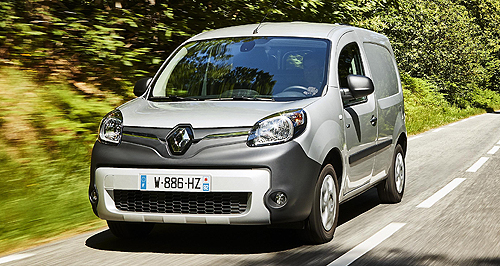First drive: Renault Kangoo ZE to cost $46K in Oz
BY HAITHAM RAZAGUI | 25th Sep 2017

It will be offered in long-wheelbase Maxi guise with four cubic metres of cargo volume and a 650kg payload, compared with 829kg for the equivalent diesel-powered model that also costs $19,000 less.
As with the Zoe electric passenger car, Renault Australia will initially sell the Kangoo ZE directly to business and government customers through its corporate sales division, with handover through specific dealerships in Melbourne and Sydney.
Speaking at a media event in Paris, Renault Australia corporate communications manager Mel Cross said the company would “initially focus on promoting these vehicles to operators with a regular back-to-base driving profile”.
“We believe Kangoo ZE will appeal to businesses that are concerned to reduce their carbon footprint and total operating costs,” she said.
“These may be within the renewable energy sector, final mile logistics deliveries, CBD-based office maintenance suppliers, resorts, hospitals, aged care facilities, local councils and even perhaps car-sharing services based at flat-pack furniture companies.”The latter could be a hint that one of Renault’s first Australian customers for the Kangoo ZE will be GoGet, a vehicle sharing service that provides membership-based van rental at Ikea stores, with joining fees waived for people in the Swedish furniture chain’s loyalty programme.
Australian-delivered Kangoo ZE vans will benefit from a recent update that has increased real-world battery range by 50 per cent to 200km, due in part to the fitment of a new 33kWh high energy density battery and upgraded 44kW/225Nm motor.
The new climate control system uses a heat pump to more efficiently warm the cabin than the previous electric heater, and can be remotely set to pre-cool or warm the interior while plugged into mains power to contributes further to the boosted battery range.
A new charger reduces the full battery charge time by an hour, meaning it takes six hours when using a 7.4kW wall box (sold separately at a cost that is yet to be decided), and a quick one hour top-up can add up to 35km of range.
Standard equipment includes the aforementioned heat pump/air-conditioning system, cruise control, rear parking sensors, a reversing camera, Bluetooth phone connectivity, unglazed rear barn doors with 180-degree opening, unglazed sliding doors on both sides and a steel bulkhead between the cargo and passenger compartments.
Warranty coverage is three years for the van and five years for the battery.
GoAuto had a brief opportunity to drive the Kangoo ZE in Paris and came away less impressed than with the Zoe electric light car we sampled on the same day, mainly because the Zoe (priced at $44,470-$45,970 plus on-road costs) was so good.
In addition to having 100km less real-world battery range than the Zoe and its larger 41kWh pack, the Kangoo ZE was also significantly slower than its punchy 68kW/220Nm passenger sibling.
Although the typically electric initial burst of acceleration was present and correct, it was not followed up by any sustained surge and even unladen it felt as though it lacked mid-range shove.
We were able to get the Kangoo ZE up to motorway speeds – eventually – and sustain them without problem, but its dull responses meant weaving Parisian-style through moving traffic was hard work and we had to abort a number of manoeuvres due to its lack of go.
Conversely, regenerative braking was strong enough that it was possible to drive the van for long periods without using the brake pedal at all – and when we did the combined force of deceleration took us by surprise. In addition to never needing oil changes, Kangoo ZE owners will surely save money on brake consumables.
We also missed the clarity of the Zoe’s digital instrument panel, because the Kangoo ZE’s binnacle contains a simple, repurposed version of the standard van’s analogue dials and shares the combustion-powered version’s problem of the steering wheel obscuring the instruments.
A dial reminiscent of an economy meter from a VH Commodore replaces the Zoe’s animated infographic showing the flow of energy during acceleration and deceleration, while battery range is indicated by conventional fuel gauge that is far less comforting than a digital kilometres-to-empty readout.
Especially as the Kangoo’s 200km real-world battery capacity is still far from eliminating the shadow of range anxiety.
Almost everything about the Kangoo ZE is identical to the combustion-powered equivalent, which is a good thing. The cabin is spacious, comfortable and practical, the load area well thought out with plenty of tie-downs and good access, visibility is OK and manoeuvrability excellent.
Compared with a petrol-powered Kangoo we drove recently, the ZE’s steering was also rather vague, but apart from that its dynamics and ride quality were as good as the standard version.
Granted, the Kangoo ZE’s quietness, smoothness and lack of vibration would prove significantly less wearing on the hard-working delivery driver than in a combustion-powered van.
And the conversion from internal combustion to electric has been executed almost seamlessly – perhaps too seamlessly and without enough differentiation given the substantial price increase.
Still, compared with the bespoke feel of the charming and similarly expensive Zoe, we could not help think the Kangoo ZE struggles to justify its $19,000 premium over a diesel Maxi, especially as that amount would buy a lot of fuel, oil changes and brake pads.
The Kangoo in standard form is an excellent compact van and we applaud the decision to import an all-electric version. But based on the strength of the combustion-powered variants and their already impressive fuel-efficiency, buyers would need a real commitment to zero tailpipe emissions in order to make the switch.
Renault Australia has done the maths and seems to think it is worth a punt, so good luck to them in attempting to move this country’s appetite for alternative fuels forward.